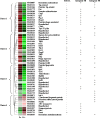Transcriptional and functional analysis of the Neisseria gonorrhoeae Fur regulon
- PMID: 19854902
- PMCID: PMC2798271
- DOI: 10.1128/JB.00741-09
Transcriptional and functional analysis of the Neisseria gonorrhoeae Fur regulon
Abstract
To ensure survival in the host, bacteria have evolved strategies to acquire the essential element iron. In Neisseria gonorrhoeae, the ferric uptake regulator Fur regulates metabolism through transcriptional control of iron-responsive genes by binding conserved Fur box (FB) sequences in promoters during iron-replete growth. Our previous studies showed that Fur also controls the transcription of secondary regulators that may, in turn, control pathways important to pathogenesis, indicating an indirect role for Fur in controlling these downstream genes. To better define the iron-regulated cascade of transcriptional control, we combined three global strategies--temporal transcriptome analysis, genomewide in silico FB prediction, and Fur titration assays (FURTA)--to detect genomic regions able to bind Fur in vivo. The majority of the 300 iron-repressed genes were predicted to be of unknown function, followed by genes involved in iron metabolism, cell communication, and intermediary metabolism. The 107 iron-induced genes encoded hypothetical proteins or energy metabolism functions. We found 28 predicted FBs in FURTA-positive clones in the promoters and within the open reading frames of iron-repressed genes. We found lower levels of conservation at critical thymidine residues involved in Fur binding in the FB sequence logos of FURTA-positive clones with intragenic FBs than in the sequence logos generated from FURTA-positive promoter regions. In electrophoretic mobility shift assay studies, intragenic FBs bound Fur with a lower affinity than intergenic FBs. Our findings further indicate that transcription under iron stress is indirectly controlled by Fur through 12 potential secondary regulators.
Figures






Similar articles
-
Characterization of the Neisseria gonorrhoeae Iron and Fur Regulatory Network.J Bacteriol. 2016 Jul 28;198(16):2180-91. doi: 10.1128/JB.00166-16. Print 2016 Aug 15. J Bacteriol. 2016. PMID: 27246574 Free PMC article.
-
Expression of the gonococcal global regulatory protein Fur and genes encompassing the Fur and iron regulon during in vitro and in vivo infection in women.J Bacteriol. 2008 May;190(9):3129-39. doi: 10.1128/JB.01830-07. Epub 2008 Feb 29. J Bacteriol. 2008. PMID: 18310343 Free PMC article.
-
Identification of iron-activated and -repressed Fur-dependent genes by transcriptome analysis of Neisseria meningitidis group B.Proc Natl Acad Sci U S A. 2003 Aug 5;100(16):9542-7. doi: 10.1073/pnas.1033001100. Epub 2003 Jul 25. Proc Natl Acad Sci U S A. 2003. PMID: 12883001 Free PMC article.
-
Beyond the Fur paradigm: iron-controlled gene expression in rhizobia.FEMS Microbiol Rev. 2006 Jul;30(4):631-48. doi: 10.1111/j.1574-6976.2006.00030.x. FEMS Microbiol Rev. 2006. PMID: 16774589 Review.
-
Living without Fur: the subtlety and complexity of iron-responsive gene regulation in the symbiotic bacterium Rhizobium and other alpha-proteobacteria.Biometals. 2007 Jun;20(3-4):501-11. doi: 10.1007/s10534-007-9085-8. Epub 2007 Feb 20. Biometals. 2007. PMID: 17310401 Review.
Cited by
-
The iron stimulon and fur regulon of Geobacter sulfurreducens and their role in energy metabolism.Appl Environ Microbiol. 2014 May;80(9):2918-27. doi: 10.1128/AEM.03916-13. Epub 2014 Feb 28. Appl Environ Microbiol. 2014. PMID: 24584254 Free PMC article.
-
Transcriptional regulation by Ferric Uptake Regulator (Fur) in pathogenic bacteria.Front Cell Infect Microbiol. 2013 Oct 2;3:59. doi: 10.3389/fcimb.2013.00059. eCollection 2013. Front Cell Infect Microbiol. 2013. PMID: 24106689 Free PMC article. Review.
-
Transcript analysis of nrrF, a Fur repressed sRNA of Neisseria gonorrhoeae.Microb Pathog. 2009 Mar;46(3):166-70. doi: 10.1016/j.micpath.2008.12.003. Epub 2009 Jan 6. Microb Pathog. 2009. PMID: 19162160 Free PMC article.
-
TonB-Dependent Transporters Expressed by Neisseria gonorrhoeae.Front Microbiol. 2011 May 27;2:117. doi: 10.3389/fmicb.2011.00117. eCollection 2011. Front Microbiol. 2011. PMID: 21747812 Free PMC article.
-
Subversion of nutritional immunity by the pathogenic Neisseriae.Pathog Dis. 2018 Feb 1;76(1):ftx112. doi: 10.1093/femspd/ftx112. Pathog Dis. 2018. PMID: 29045638 Free PMC article. Review.
References
-
- Andrews, S. C., A. K. Robinson, and F. Rodríguez-Quinones. 2003. Bacterial iron homeostasis. FEMS Microbiol. Rev. 27:215-237. - PubMed
-
- Angerer, A., and V. Braun. 1998. Iron regulates transcription of the Escherichia coli ferric citrate transport genes directly and through the transcription initiation proteins. Arch. Microbiol. 169:483-490. - PubMed
-
- Baichoo, N., T. Wang, R. Ye, and J. D. Helmann. 2002. Global analysis of the Bacillus subtilis Fur regulon and the iron starvation stimulon. Mol. Microbiol. 45:1613-1629. - PubMed
Publication types
MeSH terms
Substances
Grants and funding
LinkOut - more resources
Full Text Sources
Molecular Biology Databases

